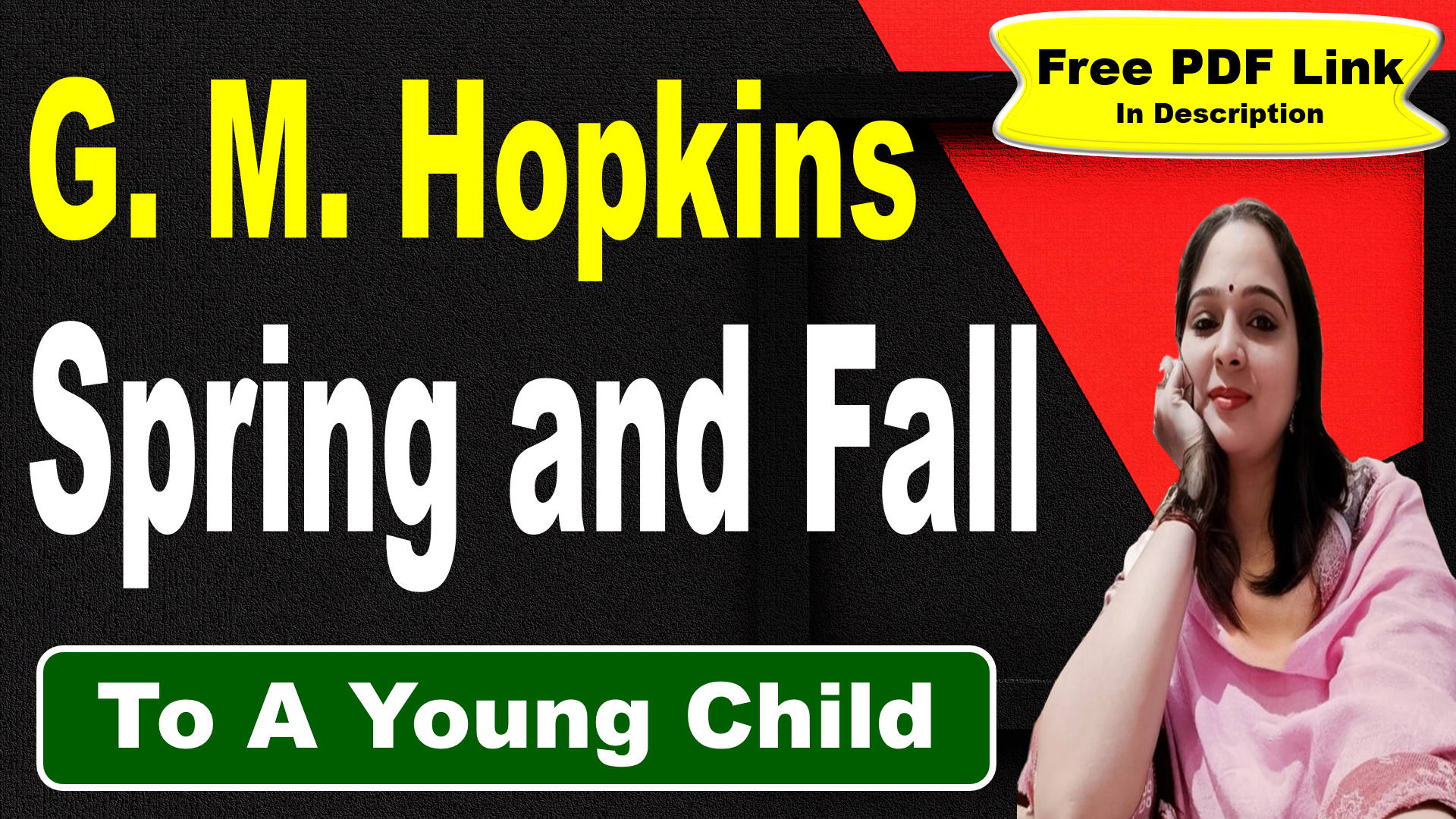Essay Type Questions
Write the critical appreciation of the poem “Spring and Fall” by Gerard Manley Hopkins.
Introduction
“Spring and Fall” is one of Gerard Manley Hopkins’ most famous and poignant poems, written in 1880. It addresses a young child, Margaret, who is grieving the falling leaves of Goldengrove. Through this simple, everyday event, Hopkins explores profound themes of loss, sorrow, and human mortality. The poem is a reflection on how human beings experience grief throughout their lives, starting from innocent childhood and growing deeper and more existential as they age.
Central Idea
The central idea of the poem revolves around human grief and mortality. Hopkins uses the falling leaves as a symbol of life’s impermanence and suggests that Margaret’s sorrow is not just for the leaves, but for the universal human experience of loss and decay. The speaker implies that as Margaret matures, she will come to understand the deeper meaning of her sorrow—it is not just for the passing of seasons, but for the inevitable fate of all living things.
Structure & Rhyme Scheme
The poem is written in 15 lines with a rhyme scheme of AABBCCDDDEEFFGG, featuring three rhymed couplets, followed by a tercet, and ending with three more couplets. This unique structure adds a musical, flowing quality to the poem, while the consistent rhyme pairs emphasize the reflective tone. Hopkins also employs sprung rhythm, a meter of his own invention that focuses on stressed syllables rather than maintaining a strict syllable count, giving the poem a conversational yet lyrical quality.
Theme
Mortality and Transience: The poem reflects on the inevitability of death, using the falling leaves of Goldengrove as a metaphor for life’s transient nature. Margaret’s initial sorrow is symbolic of the universal experience of loss that all humans must face.
Innocence and Experience: The poem contrasts the innocence of childhood, where even small things like falling leaves can evoke grief, with the more detached, philosophical understanding of sorrow that comes with age and experience.
Universal Sorrow: Hopkins suggests that all sorrow, whether it stems from the small losses of childhood or the larger existential realities of life, comes from the same deep emotional source—the awareness of mortality.
Nature as a Reflection of Human Life: The poem uses the natural process of falling leaves to mirror the inevitable cycle of human life, from birth to death.
Style
Hopkins’ style in “Spring and Fall” is distinctive, marked by his use of sprung rhythm, which creates a natural but controlled cadence in the poem. His choice of simple yet profound language reflects the deep philosophical themes, making the poem accessible while simultaneously rich in meaning. The conversational tone, combined with the emotional depth, allows the poem to engage both on a literal and metaphorical level. Hopkins’ careful attention to sound through alliteration and internal rhyme enhances the musicality of the poem.
Poetic Devices
Alliteration: Hopkins frequently uses alliteration, such as “Sorrow’s springs are the same,” to create a flowing rhythm and emphasize key emotional moments.
Simile: The line “Leáves like the things of man” compares the falling leaves to human life, reinforcing the theme of impermanence.
Personification: The poem gives human qualities to nature, such as in “Goldengrove unleaving,” where the trees are described as actively shedding their leaves.
Metaphor: The leaves serve as a metaphor for life and the inevitable process of decay and death.
Imagery: Hopkins paints vivid images of autumn, particularly in lines like “worlds of wanwood leafmeal lie,” evoking both the beauty and sadness of nature’s decay.
Critical Commentary
Several critics have praised Hopkins for the emotional and philosophical depth of “Spring and Fall.” According to Robert Bridges, who posthumously published Hopkins’ works, the poem reflects Hopkins’ preoccupation with the themes of mortality and human sorrow. Critics have also noted the poem’s innovative use of sprung rhythm and sound techniques, which were ahead of their time. Scholar Philip Endean has argued that “Spring and Fall” brilliantly captures the tension between childlike innocence and adult awareness of mortality.
Hopkins’ poetry was often misunderstood during his life, but modern critics appreciate the complexity of his thought and the musicality of his verse. His use of nature as a vehicle to explore deep philosophical and religious themes has been widely recognized as a significant contribution to Victorian poetry.
Message
The message of the poem is that sorrow is an intrinsic part of the human condition, rooted in our awareness of life’s impermanence. Margaret’s innocent grief over the falling leaves is, in fact, a reflection of a much larger truth—her own mortality and the inevitable losses that all humans face. As she matures, she will understand that her sorrow stems not just from the small changes in the world, but from the fundamental nature of life and death.
Conclusion
“Spring and Fall” is a deeply reflective poem that uses a simple scene from nature to explore universal themes of grief, mortality, and the human experience of loss. Through his innovative use of language, rhythm, and imagery, Hopkins creates a work that resonates emotionally and philosophically. The poem captures the shift from childhood innocence to the deeper awareness of sorrow that comes with adulthood, making it a profound meditation on the human condition.
Long note on themes used in the poem “Spring and Fall” by Gerard Manley Hopkins.
Mortality and Impermanence:
One of the central themes of the poem is the idea that all things, including life itself, are temporary. The falling leaves in Goldengrove symbolize the natural process of decay and death. Margaret’s sadness over the leaves reflects a deeper truth about the human experience—everything in life, including our own existence, is fleeting. As humans grow older, they become more aware of this impermanence, and Hopkins uses Margaret’s innocent grief to introduce the idea of mortality.
Innocence and Experience:
The contrast between childhood innocence and adult experience is another key theme. Margaret, as a young child, is deeply affected by the falling leaves, showing her sensitivity to even small changes in nature. This reflects her innocence and emotional vulnerability. However, the speaker suggests that as she grows older, she will become less sensitive to such things. Adults, through experience, learn to handle loss and change with a more detached or “colder” heart. This theme highlights the loss of innocence as people grow up and face life’s harsh realities.
Universal Sorrow:
Hopkins emphasizes that all sorrow comes from the same source, regardless of what we think we are grieving over. In the poem, Margaret may believe she is simply sad about the leaves falling, but the speaker explains that her sorrow is actually much deeper. It comes from the same place as the grief all humans feel when they confront loss or death. Hopkins suggests that this sorrow is a universal part of being human—no matter the cause, it ultimately stems from our awareness of life’s impermanence.
Nature as a Reflection of Human Life:
Throughout the poem, Hopkins uses nature as a metaphor for human life. The changing of the seasons, particularly the transition from summer to autumn, mirrors the stages of human life, from birth to death. The falling leaves are like the aging and passing of human beings. By focusing on Margaret’s reaction to the changing trees, Hopkins connects the natural world’s cycles with the cycles of human life, showing that both are subject to the same inevitable process of decline and renewal.
The Inescapable Human Condition:
The poem ultimately points to the fact that sorrow, loss, and death are unavoidable aspects of being human. The line “It is Margaret you mourn for” suggests that, even though Margaret doesn’t realize it, her grief is really about her own mortality. She is mourning not just for the leaves but for herself and for all humans who must face death. Hopkins calls this the “blight man was born for,” meaning that from the moment of birth, humans are destined to experience sorrow and death. This theme underscores the inescapable nature of the human condition.










